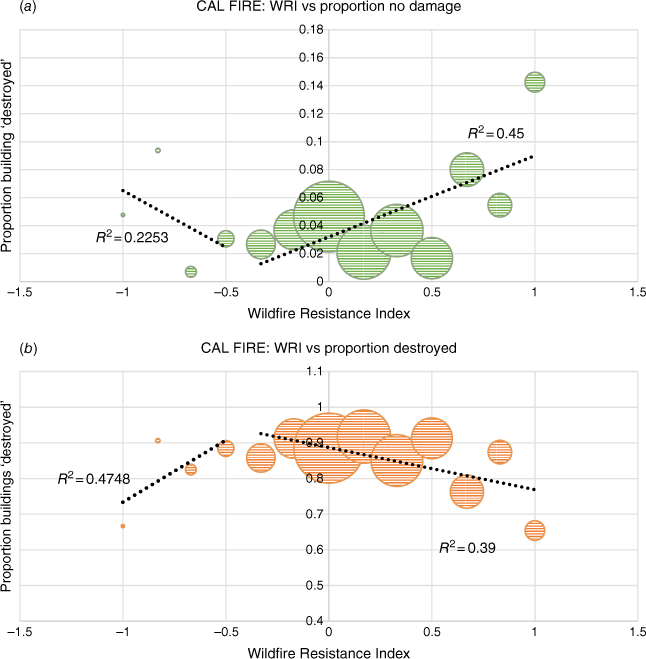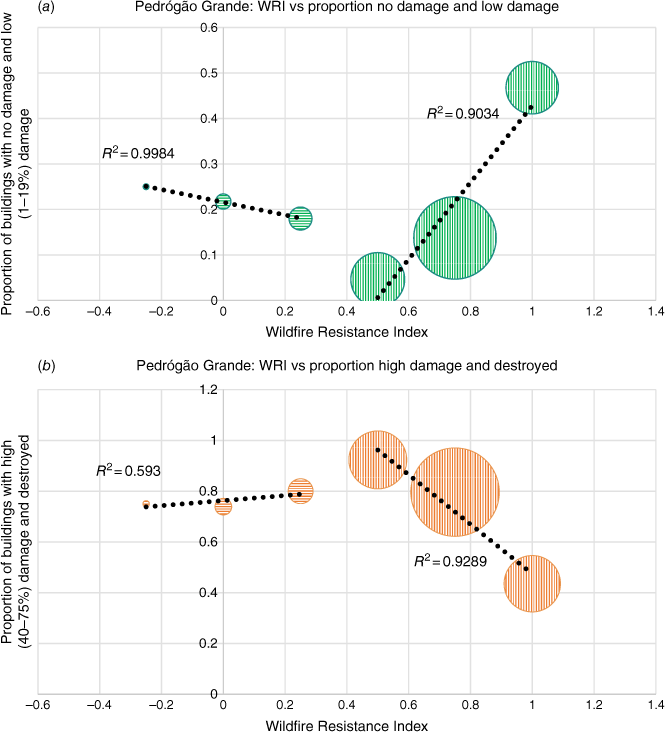Relationships between building features and wildfire damage in California, USA and Pedrógão Grande, Portugal
Simona Dossi A , Birgitte Messerschmidt B , Luís Mário Ribeiro C , Miguel Almeida C and Guillermo Rein A *
A *
A Department of Mechanical Engineering, and Leverhulme Centre for Wildfires, Environment, and Society, Imperial College London, London, UK.
B National Fire Protection Association, Quincy, MA, USA.
C University of Coimbra, ADAI, Coimbra, Portugal.
International Journal of Wildland Fire 32(2) 296-312 https://doi.org/10.1071/WF22095
Submitted: 17 March 2022 Accepted: 6 November 2022 Published: 23 December 2022
© 2023 The Author(s) (or their employer(s)). Published by CSIRO Publishing on behalf of IAWF. This is an open access article distributed under the Creative Commons Attribution-NonCommercial-NoDerivatives 4.0 International License (CC BY-NC-ND)
Abstract
Background: Buildings in communities near wildlands, in the wildland–urban interface (WUI), can experience wildfire damage.
Aims: To quantitatively assess the relationship between building features and damage, a building wildfire resistance index is developed and validated with the 2013–2017 CAL FIRE (DINS) database from California, USA, and the 2017 Pedrógão Grande Fire Complex post-fire investigation from Portugal.
Methods: Three statistical dependence tests are compared to evaluate the relationship between selected building features and damage. The Wildfire Resistance Index (WRI), range: [–1, 1], is proposed and validated as a rating for building wildfire susceptibility.
Key results: The most correlated features to wildfire damage are the presence of vent screens and deck materials in California, and exterior walls material and deck materials in Portugal. For Portugal, as WRI increases by 50%, linear regression estimates a 48% decrease in proportion of highly damaged buildings, and a 42% increase in proportion of low damage buildings (R2 of 0.93 and 0.90, respectively). A total of 65% of California buildings with WRI = 1 were destroyed, compared to average 85% for WRI ≥−0.33.
Conclusions: The WRI quantifies the wildfire damage experienced by buildings in two diverse WUI regions.
Implications: The WRI could be used as an estimator of wildfire damage but it needs further development.
Keywords: buildings, California wildfire, case study, damage, ignition, Portugal wildfire, statistical analysis, vulnerability, wildfire, wildland–urban interface.
Introduction
Wildland–urban interface fires
Wildfires are a complex natural phenomenon, threatening communities and infrastructures worldwide (Manzello et al. 2018). The wildland–urban interface (WUI) refers to the built environment adjacent to, or intermixed with, wildlands (Butler 1974). WUI fuels include buildings, vehicles, vegetation, and other combustibles in the WUI; when wildfires ignite these fuels, WUI fires are initiated. In 2021 alone, wildfires in the USA destroyed 4299 buildings, and suppression costs amounted to US$4.4 billion, or €3.9 billion (Southern Area Coordination Center (SACC) 2021). Fuel properties (including bulk, particle, physical and chemical properties), topography, and weather all affect wildfire spread and behaviour; the variety of fuel materials and densities in residential areas contribute to the complexity of understanding WUI fire behaviour and hazard (Simeoni 2016).
Due to their human safety and economic damage threats, it is important to increase WUI fire risk reduction knowledge and tactics. Post-fire inspection studies (e.g. Graham et al. 2012), wildfire exposure modelling and experiments (e.g. Cohen and Butler 1998; Cohen 2004; Biswas et al. 2013), and statistical data analysis (e.g. Syphard et al. 2012; Knapp et al. 2021) have indicated that it is the condition of the building construction and its immediate surroundings, which primarily control the building ignition and damage probability. Limiting combustibles in these immediate surroundings is often referred as creating ‘defensible space’; the relevant surrounding area, including the building, is known as the Home Ignition Zone (HIZ) (Smith and Adams 1991; Cohen 2008). The wider residential area planning, road access, and emergency service availability, can also influence the fire exposure and damage extent (NFPA 1140 2022). Table 1 lists all contributing factors identified in literature as significant in affecting wildfire building ignition and damage.
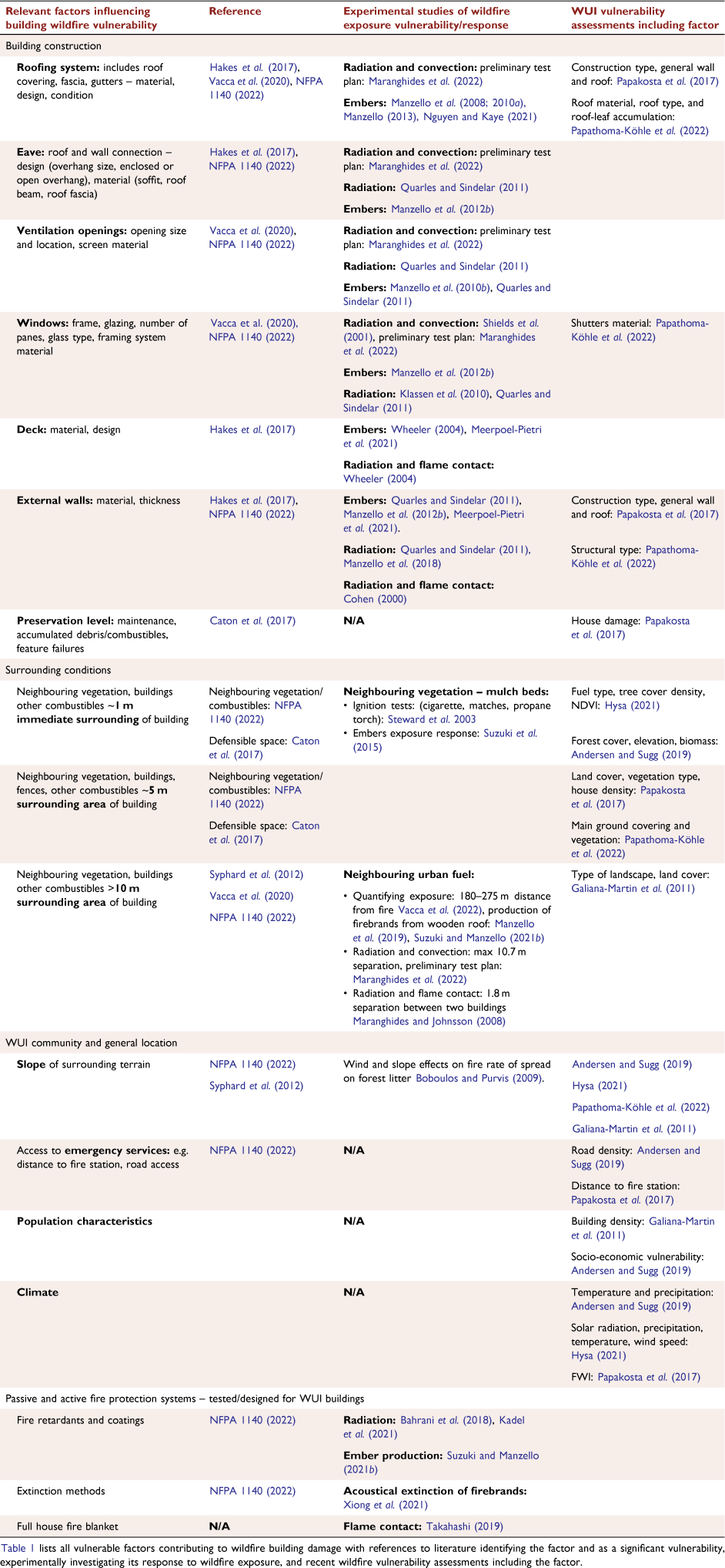
|
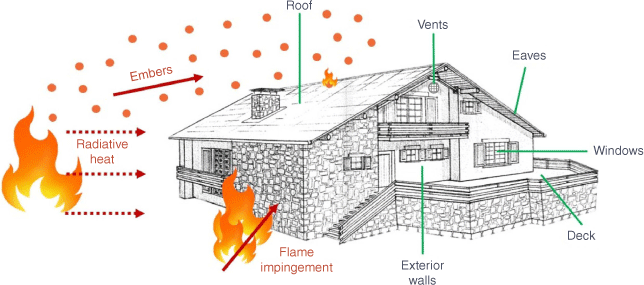
|
Building ignition mechanisms
Ignition, the activation of a sustained combustion reaction, of building features by wildfire occurs through three primary exposure mechanisms: (1) flame impingement; (2) flame radiation; and (3) ember ignition (Caton et al. 2017; Fig. 1). Flame impingement refers to direct contact between flames and fuel. Fire spread by flame contact involves both radiation and convection. Breakthrough experiments across various spatial scales discovered that flame contact ignition of fine fuels correlate with the instabilities generated by buoyancy in the flame zone (Finney et al. 2015). Thermal radiation allows heat transfer without direct contact with fuel, and it is an important heat transfer mechanism; flame radiation has been calculated as accounting for up to 80% of heat transfer for upward spread of flames taller than 76 cm (Orloff et al. 1975). Experiments indicate that as flame height increases, the heat flux remains approximately constant but the exposure area increases (Babrauskas 2003). Embers or firebrands, are aerodynamically buoyant burning fragments of fuel which can ignite fuels at far distances away from flames (Lautenberger and Fernandez-Pello 2009).
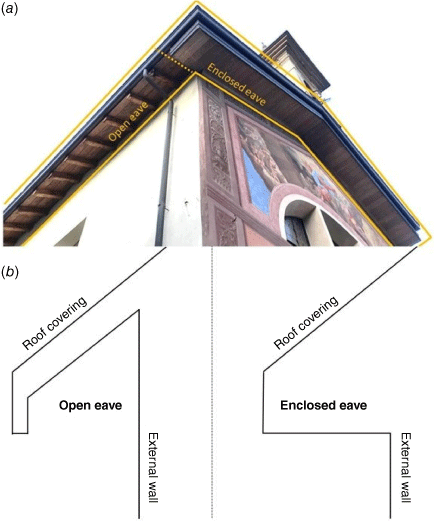
|
Embers are often found as the primary cause of building ignitions, both in post-fire inspections and experimental studies (Blanchi et al. 2006; Hakes et al. 2017; Ribeiro et al. 2020). Embers can directly ignite building features by landing and accumulating on their outer surface, or by entering through openings and igniting the building’s interior. Embers can also indirectly ignite buildings by igniting adjacent fuel and starting fires that can in turn ignite the building through flame radiation or impingement. Embers are generated as fuel burn, lofted by the fire-induced plume, transported aerodynamically in the wind, to finally land and possibly accumulate and ignite fuel; detailed reviews of these processes are available (Babrauskas 2003; Lautenberger and Fernandez-Pello 2009; Koo et al. 2010; Manzello et al. 2012a). The combined exposure effect of radiative heat flux and embers on ignition of fuel has been recently studied through laboratory experiments (Suzuki and Manzello 2021a).
The ignition process of building features can be studied as flaming ignition of a solid caused by external heat (Torero 2016). Combustible solids, when exposed to enough heat, will undergo pyrolysis and release pyrolysed vapours that react with oxygen to form a flame. The physical and chemical properties of the solid material determine its response to heat exposure, and therefore its ignition thresholds per a given exposure. The most common vulnerable features involved in wildfire building ignition are labelled in Fig. 1 as identified in literature (Quarles et al. 2010; Hakes et al. 2017). Table 1 references experimental investigations of each contributing factor’s response to wildfire exposure, each factor’s inclusion in WUI vulnerability assessments. Rather than a comprehensive literature review, this table serves as a reflection of contributing factors to vulnerability and their respective inclusion in recent vulnerability assessments. Fig. 2 illustrates the differences in eave geometry, mentioned in Table 1.
Vulnerability assessments
Assessing WUI fire ignition, spread, and damage risk is complex and requires the integration of many variables. Given the complexity of possible wildfire exposures and vulnerabilities, detailed fire risk assessments of buildings are limited, and not viable on large-scale application due to data availability, financial and time constraints. Risk indexing is a quantitative, cost-effective methodology that can be used as a prioritisation tool when detailed engineering risk analysis is not possible. Indexing uses simplified fire safety models that produce quantitative risk ranking (Watts 2008). Table 2 provides a list of recent WUI vulnerability assessments, each considering different geographical areas, contributing vulnerability factors, and quantification methodologies. The lack of studies focusing on the building construction area despite its widely recognised crucial importance (IBHS 2021), indicates a gap in literature addressed here with the development and validation of the Wildfire Resistance Index (WRI).

|
The only quantitative WUI building wildfire vulnerability indexes known to authors are Wilson (1984) and Papathoma-Köhle et al. (2022). Wilson considered 450 houses exposed to bushfire in Australia; the study considered fire intensity, attendance by residents, roof material, wall material, presence of flammable objects and surrounding vegetation (Wilson 1984). Papathoma-Köhle et al. (2022) considered 423 buildings affected by the 2018 fires in Mati, Greece and created the Physical Vulnerability Index (PVI) by statistically weighing selected variable relating to building features, terrain slope, and surrounding vegetation. Here, we expanded this approach by considering two different geographical regions, and a larger sample of buildings (Papathoma-Köhle et al. 2022). We considered two different geographical regions (USA and Portugal) and developed the WRI, a preliminary risk index specifically applied to rural buildings. The objectives were to quantify the relationship between selected building features and wildfire damage, and validate our methodology with data from two diverse WUI regions.
Case studies: California and Pedrógão Grande
In this paper, we consider 17 500 buildings exposed to 59 wildfires in California, USA between 2013 and 2017, from the CAL FIRE (DINS) database of wildfire damage inspections (Henning et al. 2016); and 1190 buildings exposed to the 2017 Pedrógão Grande Fire Complex in Portugal from the comprehensive damage inspection of exposed buildings conducted by ADAI (Ribeiro et al. 2020). The databases were selected because of their large sample size, and the amount of building construction design information included, which allows meaningful statistical analysis. The two geographical regions considered (California and rural Portugal) both experienced significant WUI damage. In 2021, California was estimated to have over 2 million properties with high or extreme wildfire risk, the highest number of all USA states (Verisk 2022). The estimated damage caused by the 2017 fires in Portugal, between June and October is €1.5 billion, 97% of which attributed to physical damage (San-Miguel-Ayanz et al. 2021). Lastly, the presented methodology can serve to compare wildfire vulnerability of different WUI constructions styles. Table 3 provides background information on common building materials used in the USA and Portugal for the external building envelope and roofing system, and information on differences in construction materials in the regions.

|
In both databases, the dependent variable is damage level; it is characterised between six possible levels in the CAL FIRE database: (0) No Damage, (1) 1–9%, (2) 10–25%, (3) 26–50%, (4) 51–75%, and (5) Destroyed, and between five levels in the Pedrógão Grande Fire Complex database: (0) No Damage, (1) 1–19%, (2) 20–39%, (3) 40–75%, and (4) Destroyed. We note the damage level ranges differ between the two databases. Other important differences include the number of inspectors and inspectors’ training; these factors can influence the definition and type of data collected. The California database was collected by numerous inspectors over 5 years, the Portuguese data was collected by one team of two inspectors, which increased consistency. All information relating to building construction and condition was selected as independent variables. In the CAL FIRE database, these variables are roof material, number of windowpanes, exterior walls material, eaves presence, deck material, and vents presence. In the Pedrógão Grande Fire Complex database, exterior walls material, preservation level, roof material and, deck material are the independent variables.
Descriptive statistics
Bar graphs of the number of inspected buildings per damage level, which illustrate the damage level distribution for the CAL FIRE database, and Pedrógão Grande database are in Fig. 3. Note that the damage levels are defined differently in each database. Fig. 3a illustrates the large skewness of the CAL FIRE data toward ‘Destroyed’ buildings. The vast majority (87.4%) of buildings inspected post wildfire were completely destroyed; this indicates the severity of WUI fire in California. Fig. 3b presents a more even distribution for the Pedrógão Grande Fire Complex damage; 38.5% of inspected building characterised as destroyed, and 36.3% as highly damaged (damage level of 40–75%). These distributions illustrate an inherent difference in wildfire building resilience between the regions, despite differing damage level definitions.
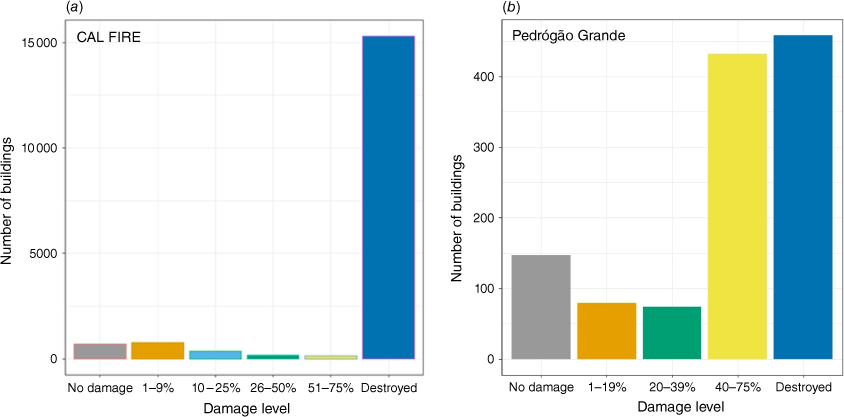
|
The independent variables considered are the available variable describing the building; either relating to the building features (e.g.: roof, walls, deck) or building condition (e.g. preservation level). All possible characterisations (except for missing data) for each variable are summarised in Tables 4 and 5 for the CAL FIRE and Pedrógão Grande Fire Complex databases, respectively. ‘N/A’ refers to buildings that did not have the feature in question; some buildings do not have any decks, or eaves when buildings lack overhang at connection between the roof and external wall; e.g. mobile homes, trailers, metal roofs. All characteristics listed in Tables 4 and 5 are classified as providing lower or higher levels of fire protection to the building. The fire protection classification is based on published knowledge on fire protection of various materials and designs (Table 1); and is relative to the other characterisations available in the relevant database for the same feature variable. Fig. 4a, b shows the proportion of variables classifies as offering low fire protection, high fire protection, or unknown, for the CAL FIRE database and Pedrógão Grande Fire Complex database, respectively. The Pedrógão Grande database ranges from 80% high fire protection characteristics (exterior walls material and preservation level) to 99% high fire protection (deck material). In contrast, for the CAL FIRE database, the average percentage of high fire protection characteristics is 31%; ranging from a minimum of 1% high fire protection (eave geometries), to a maximum of 75% of high fire protection (roof material). Pie graphs showing detailed subdivision of all possible variable characteristics are presented for variables with three or more possible characteristics. Fig. 5a, b shows the distribution for the deck material, and eaves geometry in the CAL FIRE data. Fig. 6a, b shows the distribution of preservation level and external walls in the Pedrógão Grande data.
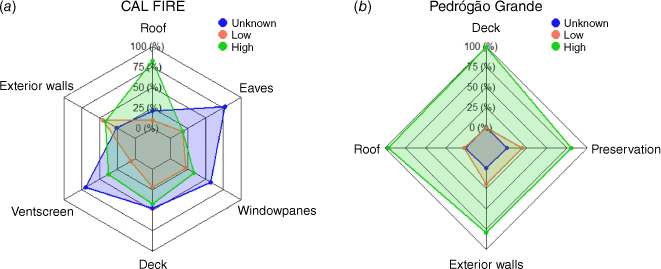
|
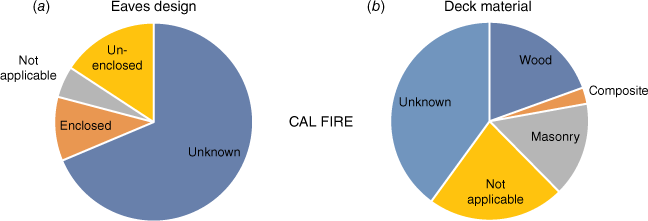
|
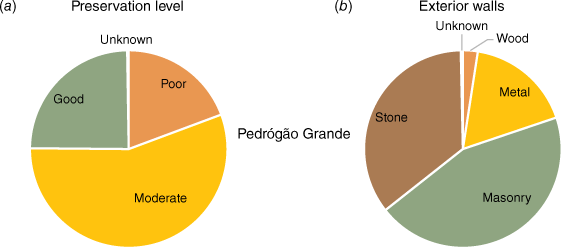
|

|
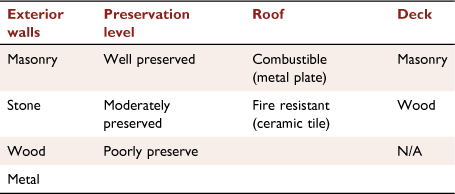
|
Handling missing data
Tables 6 and 7 summarise the percentage missing data for each independent variable considered for the CAL FIRE and Pedrógão Grande databases respectively. CAL FIRE data includes as high as 69% (eave geometry) of missing data per building feature variable; if disregarded, the high proportion of unknown data can introduce bias in the analysis (Pampaka et al. 2016). Two different types of analysis are presented in this paper: (1) the ranking of relative importance of independent building feature variables for wildfire damage (see Methodology: Statistical dependence tests section below); and (2) the WRI development and validation (see Methodology: WRI section). Missing value imputation is used to handle missing data for the ranking analysis. The WRI calculations use the original databases, without imputation; missing data is assigned a coefficient of 0 to not influence the final WRI value instead. An iterative imputation method based on a random forest, computed with RStudio 1.3.1093 package ‘missForest’, is chosen as imputation method due to the low computational power and time required, and its built-in imputation error estimation: the random forest out-of-bag error (Stekhoven and Bühlmann 2012). The out-of-bag error, proportion of falsely classified, for the imputed CAL FIRE data is 19.9, and 27.6% for the Pedrógão Grande data.
|
|
|
|
Methodology
Statistical dependence tests
Statistical dependence tests were conducted to analyse and quantify the correlation between each building feature (independent variables) and damage level (dependent variable). Given the complexity of the variables correlation (numerous independent variables, all correlated with each other, with unconsidered variables, and with the dependent variable), and the level of uncertainty in the databases (due to missing data discussed above in the Methodology: Handling missing data section), three applicable statistical dependence tests based on different statistical methods were conducted and compared: (1) the Bayes Factor (BF); (2) the Chi Square test of independence with Cramèr’s V; and (3) the Boruta feature selection using random forests. For the BF and Chi Square test, the null hypothesis is defined as no relationship between building feature and damage, or that wildfire building damage is independent of the building feature characteristic considered. All calculations are computed with RStudio 1.3.1093, with packages ‘BayesFactor’, ‘lsr’, and ‘Boruta’.
The BF is the ratio between the probability of the alternative hypothesis, and the probability of the null hypothesis being true based on the observed data (Lee and Wagenmakers 2014). The higher the value of the BF, the stronger the evidence against the null hypothesis is in the data (Gûnel and Dickey 1974; Rouder et al. 2009). Eqn 1 describes the BF where P(x) is the probability of x, D is the observed data, Malt is the model for the alternate hypothesis, and Mnull is the model for the null hypothesis.

The BF in this study is calculated assuming a Poisson sampling plan, referring to the fact that neither the number of buildings exposed to wildfire, nor the variables considered were pre-determined before the inspections (Gûnel and Dickey 1974; Rouder et al. 2009).
The Pearson’s Chi Square Test of Independence evaluates the likelihood that a particular distribution occurred randomly, or without any significant relationship between independent and dependent variables. Eqn 2 defines the Chi Square χ2 value, I and J are the independent and dependent variables, and i and j are each variable’s possible characteristics, Eij is the expected number of combinations of variables assuming the null hypothesis, and Oij the observed number of combinations. The P-value threshold is taken as 0.001, corresponding to 99.9% confidence of statistically significant dependence.

Cramèr’s V is calculated to estimate the effect size, or strength, of the relationship between variables. Cramèr’s V is based on the Chi Square value and ranges from 0 to 1; the greater the value, the stronger the estimated relationship is. Eqn 3 defines Cramèr’s V, and n is the sample size.

Lastly, Boruta feature selection uses calculated importance scores provided by Random Forest algorithms and compares them to those of randomly generated ‘shadow variables’ to calculate relative importance of each independent variable. The shadow variables are generated by randomly shuffling original variables in order to maintain the existing distribution but eliminate their correlation to the dependent variable. All variables that rank of higher importance than the shadow variables are selected as relevant features (Kursa and Rudnicki 2010).
WRI
A simple WRI was created for each building, in order to compare the cumulative effect of multiple building features on wildfire damage. A fire protection coefficient of −1, 0, or 1, is assigned to each building feature characteristic (1 corresponds to higher fire protection, −1 to lower fire protection, and 0 to unknown or intermediate characteristics). These coefficients are summed for all features of every building, and normalised to the range [−1, 1] by dividing by the maximum index value of the sample data. Eqn 4 describes this calculation; where WRI is the wildfire resistance index, and Ci is the coefficient assigned to building feature i.

The WRI relates to the relative number of characteristics offering high fire protection, compared to characteristics offering lower fire protection. A value of 1, therefore, refers to buildings classified as having all possible high fire protection characteristics, and a value of −1 to buildings having only lower fire protection characteristic possible. An assumption of this WRI definition is that all building features contribute equally (the authors note this is a preliminary development stage, and limitations of current WRI methodology are fully presented in the discussion). Tables 8, 9 provide the Ci values for both databases. Note that the exterior wall material ‘metal’ is classified as providing ‘low fire protection’; metal wall material most commonly refers to thin (<1 mm thick) aluminium, galvanised or zinc plated, sheets used in low value structures. This material is more susceptible to fire exposure compared to other wall material options. All classification decisions are based on building component response to wildfire exposure literature, as summarised in Table 1.

|

|
Results
Statistical dependence tests
Tables 10 and 11 present the statistical dependence tests results for each database. The results include the Chi Square value, its associated P-value (indicates statistical significance of correlation), Cramèr’s V value and associated degrees of freedom (necessary for Cramèr’s V value interpretation) (Cohen 1988), the BF value, and the median importance value calculated with Boruta feature selection. Each table includes ‘ranking’ columns presenting the relative rank of variable importance for each dependence test; the rank is colour-coded with darker colours corresponding to higher correlation to damage level. Dependence test results of similar magnitude are interpreted as having the same correlation ranking, to give a conservative ranking and account for uncertainty. Fig. 7a, b presents the graphical visualisation of importance values calculated with the Boruta feature selection method, and how they compare to shadow features importance. All independent variables considered are found to be statistically significantly correlated to damage level by all the statistical methods applied.
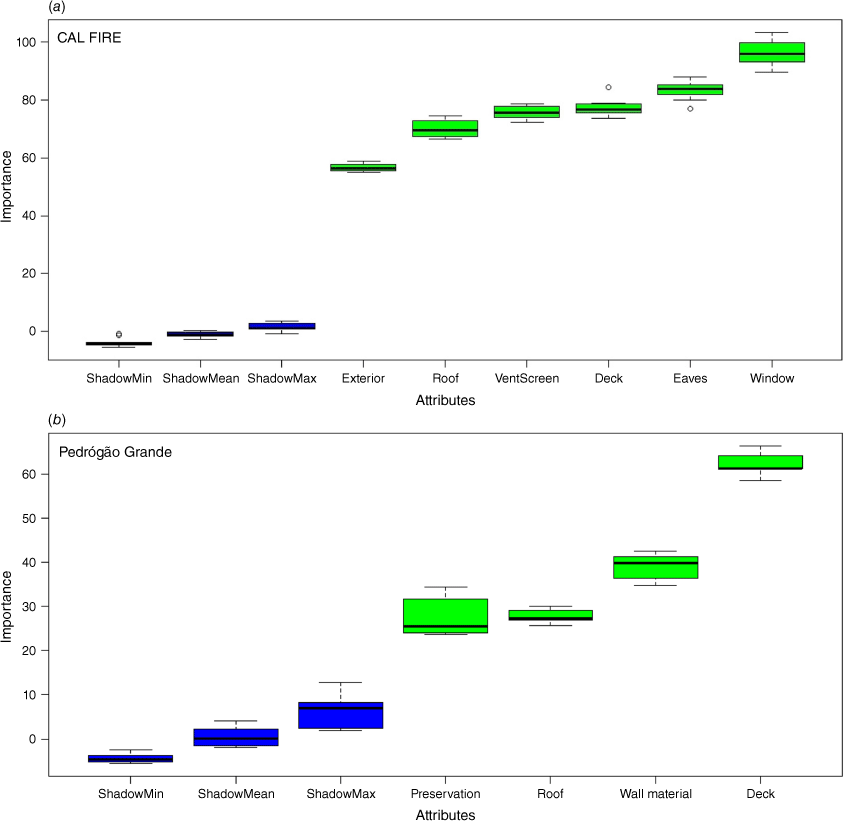
|

|

|
The Cramèr’s V and BF analysis agree on the ranking of relative correlation strength for the CAL FIRE independent variables; i.e. vent screens, deck material, and exterior wall material rank as having the highest correlation, followed by eaves design, roof material, and number of window panes ranking as having the lowest correlation to damage level. The Boruta feature selection results disagree, and result in opposite ranking for number of windowpanes, with the highest correlation to damage level, and exterior wall material, ranking with the lowest correlation to damage level. For the Pedrógão Grande database, the BF and Cramèr’s V analysis agree in the ranking of the building features’ correlation: exterior wall material ranks as most highly correlated, followed by deck material, preservation level, and least strongly correlated is roof material. The Boruta analysis ranks deck material as most highly correlated, followed by exterior material, and lastly roof material and preservation level with comparable ranking.
WRI
Fig. 8 shows damage level distributions plotted against WRI values, and illustrates distribution with boxplots, and jitter plots showing the relative concentration of buildings with each damage level and WRI value combination. Due to the large variation in number of buildings present with each WRI value, the WRI is plotted against the proportion of buildings in each WRI value with the damage level indicated in Figs 9 and 10. This approach resolves the skewness of the distribution that otherwise inhibits observing a relationship between the variables. The size of the circles plotted is proportional to the number of buildings with each WRI value. Two distinct linear correlations are fitted in each figure to reflect two observed trends; our analysis focuses on correlations including the larger number of buildings, indicating more accurate results.
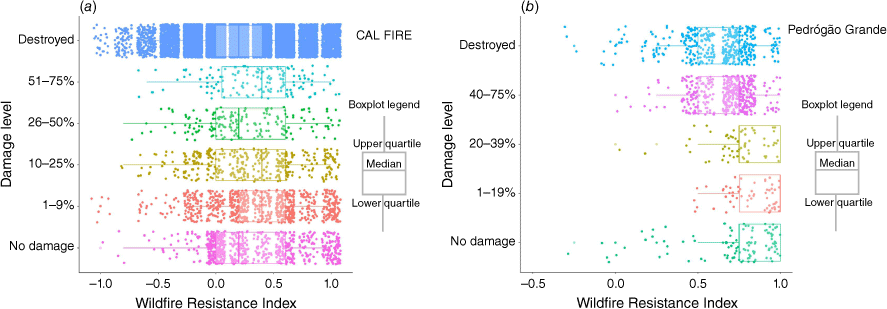
|
In the Pedrógão Grande data (Fig. 10), the three highest WRI values (0.5, 0.75, and 1) include the largest sample size (>248 buildings) and give a positive linear correlation to proportion of ‘no damage’ and ‘low damage’ buildings (R2 = 0.90). This correlation estimates, for a WRI increase of 0.5, an increase in proportion of no and low damage of approximately 42%. A negative linear correlation (R2 = 0.93) is found between the same WRI values (0.5, 0.75, and 1), and the proportion of ‘high damage’ and ‘destroyed’ buildings. This correlation estimates that, for a WRI increase of 0.5, the proportion of highly damaged and destroyed buildings decreases by approximately 48%.
In the CAL FIRE data (Fig. 9), WRI values −0.33 to 1 include sample sizes ranging from 428 to 2909 buildings, while the WRI values <−0.33 have sample sizes <294 buildings. For WRI values ≥−0.33, less accurate linear correlations compared to the Pedrógão Grande data are found, which follow similar trends. A negative linear correlation (R2 = 0.39) is found between increasing WRI values and proportion of ‘destroyed’ buildings. A positive linear correlation (R2 = 0.45) is found between WRI and proportion of survived buildings. The authors note that WRI = 1, corresponding to buildings with all features providing high fire protection, is an outlier but included in both linear trends. This value therefore reduces the R2 value, and suggests a significantly higher proportion of survived and significantly lower proportion of destroyed buildings with WRI = 1. The authors also tested a WRI version that considers all building features except eave geometry; this was tested due to uncertainty in literature regarding the wildfire vulnerability of eaves. This WRI version resulted in more accurate correlations; a negative linear correlation (R2 = 0.76) between WRI values ≥−0.33 and ‘destroyed’ buildings proportion, and a positive linear correlation (R2 = 0.63) with proportion of survived buildings.
Discussion
Statistical dependence tests
All statistical methods employed, for both databases, rank deck material as one of the most highly correlated building features to damage, and rank roof material as poorly correlated building features to damage. Exterior material also ranks highly correlated to damage in both databases, except for the Boruta feature method with the CAL FIRE database which ranks number of windowpanes as most correlated and exterior material as least.
The low ranking of the roof material relevance to wildfire damage disagrees with similar published index (PVI) applied to Mati, Greece post-fire data (Papathoma-Köhle et al. 2022). The authors infer this difference is due to the amount of detail information included in the roof material data; the PVI roof material considers five possible materials, describing both the roof frame and covering (Papathoma-Köhle et al. 2022). Our WRI only considers two roof covering materials: (1) fire resistant; and (2) non-fire resistant. Given the size and complexity of roofing systems, unconsidered details (e.g. frame material, design, debris accumulation) may all contribute to wildfire damage. This is supported by recent experiments investigating ember accumulation on roofs that concluded the area where embers contact the roof is a complex function of the building shape, roof angle, and wind angle (Nguyen and Kaye 2021).
The high-ranking correlation of the deck and exterior material variables supports the importance of defensible space in wildfire damage. The deck variable, in both databases, includes the differentiation between buildings with and without a deck, as well as what material the deck is primarily constructed of. These conditions directly relate to the building’s defensible space condition. Furthermore, exterior wall material is primarily vulnerable to flame radiation and impingement, which are strongly impacted by the defensible space condition. Including more detailed information on the condition of deck (e.g. amount and condition of combustibles, accumulated debris) in future damage inspections can help further explore its role in wildfire damage (Quarles and Standohar-Alfano 2018).
For the CAL FIRE database, vent screens and eaves geometry both rank with relatively high correlations to damage level. These features are both associated with ember exposure. Vent screens only protect from ember exposure, and eave geometry increases building vulnerability to embers and flame impingement. Furthermore, deck vulnerability to embers has been extensively documented and investigated (Wheeler 2004; Manzello and Suzuki 2014; Meerpoel-Pietri et al. 2021). The high ranking of these three features can indicate the importance of ember exposure in building ignition and damage, agreeing with existing literature (Maranghides and Mell 2012; Ribeiro et al. 2020).
The disagreement in ranking the relevance of number of windowpanes between the Boruta feature selection method, and the Cramèr’s V and BF methods, highlights the importance of testing various statistical dependence tests and of standardising data collection to minimise variations. The amount of missing data in the original databases, as well as the lack of detail of certain building feature characteristics introduce limitations to statistical test accuracy. This is quantified by the imputation out-of-bag error; approximately 20% for the CAL FIRE data, and 28% for the Pedrógão Grande data. Missing data, and lack of detail are expected limitations of post-fire damage data given the complications of collecting vast and detailed field data. Recommendations for future data collections include focusing on more detail for the roofing system, and standardising data collection with existing databases to facilitate comparison and extension of lessons learnt.
WRI
The WRI is a building wildfire protection index based on currently available post-fire inspections data, and easily calculated with Eqn 4. The correlations found between the WRI and damage level confirm including the greatest number of high fire protection features in a building, has a significant impact on increasing its wildfire survivability; emphasising the importance of holistic fire safety constructions rather than hardening isolated building features. The Pedrógão Grande data’s linear correlations estimate, for a WRI increase of 0.5, a decrease in the proportion of highly damaged and destroyed buildings of 48%, and increase in proportion of low or no damage buildings of 42% (R2 of 0.93 and 0.90). These significant increases confirm that for Portuguese rural WUI an increase in fire protection level of exterior wall material, deck material, preservation level, and roof material can significantly impact the survivability of buildings. Contrastingly, the CAL FIRE data WRI did not correlate as accurately with damage level (R2 of 0.39 and 0.45), this can suggest that building vulnerability in California is more strongly controlled by factors not considered in the WRI (e.g. building-to-building separation distance, defensible space condition). However, buildings with a WRI of 1 (only have high-fire protection features) exhibit exceptionally high proportion of survival (14.2% compared to an average of 5.13% for buildings with WRI ≥−0.33), and low proportion of destroyed buildings (65.4% compared to an average of 84.8% for buildings with WRI ≥−0.33). These values suggest that buildings that only have characteristics offering higher fire protection are significantly more resistant to wildfire damage. A second CAL FIRE WRI variation excluding the ‘eave geometry’ building feature, resulted in more accurate linear correlations (R2 of 0.76 and 0.63) values to the proportion of destroyed and survived buildings. The authors recommend careful assessment of which features to include in the WRI based on specific local building characteristics.
The following WRI limitations can explain the variance in the data observed, and need to be considered and addressed prior to further application in fire spread models or WUI building risk assessments; the WRI is not weighted, it only accounts for building construction features and maintenance level, and needs to be validated with more data to confirm correlations. In contrast to recently published PVI index (Papathoma-Köhle et al. 2022), the WRI assumes all features considered contribute equally to the building vulnerability; this assumption is a limitation as in reality certain building features will contribute more significantly to wildfire ignition and spread. The decision to not weigh the various building features was made to calculate a baseline correlation when only considering the relative number features providing high fire protection, and due to disagreement in building feature ranking resulting from the statistical dependence tests conducted. The WRI only considers factors contributing to building construction vulnerability, as this is a gap in existing WUI vulnerability assessment methods in literature. Before implementation authors recommend to couple a consideration relating to the building defensible space condition, e.g. (Hysa 2021), to the WRI. For future building vulnerability data collections, we recommend recording the fire protection level for each significant influencing feature (e.g. roofing system, windows, external walls) in terms of three significant aspects: (1) material properties, (2) geometry or design and (3) preservation level. Fire protection levels for the three vulnerability aspects can be based on available literature, summarised in Table 1, and can all be included in the WRI calculation for improved accuracy. Lastly, the small sample size of buildings with low WRI values (maximum of 50 buildings of WRI <0.5 in the Pedrógão Grande data, and maximum of 294 buildings of WRI ≤0.5 in the CAL FIRE database) poses limits to the validation; validating the methodology with more evenly distributed data can increase its value and accuracy. The authors note that small sample sizes and missing data are normal occurrences in post-fire damage databases given the difficulty of collecting relevant data in post-fire WUI.
Conclusion
This paper investigates the relationship between the WUI building features and building wildfire damage level in two post-fire databases from California and Portugal. We propose a quantitative methodology to compare the wildfire vulnerability to the damage of WUI homes in terms of individual building features, with three statistical dependence tests, and of the entire building construction, with the novel Wildfire Resistance Index (WRI). This is the first wildfire vulnerability index in literature considering building construction features in more than one WUI regions.
For buildings in California, we found that the presence of vent screens, and deck material flammability are highly correlated to damage level. For buildings exposed to the Pedrógão Grande Fire Complex in Portugal, exterior walls and deck materials flammability were most highly related to damage level. The WRI is proposed to quantify and assess the need for wildfire protection in WUI buildings. This is a new index, needing further development and validation with region-specific data before operational use. In future, the WRI can be used for WUI fire spread prediction in wildfire spread numerical models, and in local stakeholders’ decision making.
Data availability
The data that support this study were obtained from CAL FIRE, NFPA, and ADAI by permission/licence. Data will be shared upon request to the corresponding author with permission from all parties.
Conflicts of interest
The authors declare no conflicts of interest.
Declaration of funding
This project has received funding from the European Union’s Horizon 2020 research and innovation programme under the Marie Skłodowska-Curie grant agreement No 860787.
References
Andersen LM, Sugg MM (2019) Geographic multi-criteria evaluation and validation: A case study of wildfire vulnerability in Western North Carolina, USA following the 2016 wildfires. International Journal of Disaster Risk Reduction 39, 101123| Geographic multi-criteria evaluation and validation: A case study of wildfire vulnerability in Western North Carolina, USA following the 2016 wildfires.Crossref | GoogleScholarGoogle Scholar |
Babrauskas V (2003) Ignition Sources. In ‘Ignition Handbook’. pp. 497–590. (Fire Science Publishers)
Bahrani B, Hemmati V, Zhou A, Quarles SL (2018) Effects of natural weathering on the fire properties of intumescent fire-retardant coatings. Fire and Materials 42, 413–423.
| Effects of natural weathering on the fire properties of intumescent fire-retardant coatings.Crossref | GoogleScholarGoogle Scholar |
Barrett K, Quarles SL, Gorham DJ (2022) Construction Costs for a Wildfire-Resistant Home: California Edition. Available at https://headwaterseconomics.org/natural-hazards/wildfire-resistant-costs-california/
Biswas K, Werth D, Gupta N (2013) A home ignition assessment model applied to structures in the wildland-urban interface. In ‘Thermal Performance of the Exterior Envelopes of Whole Buildings XII International Conference’. Available at https://web.ornl.gov/sci/buildings/conf-archive/2013%20B12%20papers/085_Biswas.pdf
Blanchi R, Leonard JE, Leicester RH (2006) Lessons learnt from post-bushfire surveys at the urban interface in Australia. Forest Ecology and Management 234, S139
| Lessons learnt from post-bushfire surveys at the urban interface in Australia.Crossref | GoogleScholarGoogle Scholar |
Boboulos M, Purvis MRI (2009) Wind and slope effects on ROS during the fire propagation in East-Mediterranean pine forest litter. Fire Safety Journal 44, 764–769.
| Wind and slope effects on ROS during the fire propagation in East-Mediterranean pine forest litter.Crossref | GoogleScholarGoogle Scholar |
Butler CP (1974) The Urban/Wildland Fire Interface. Proceedings of Western Stattes Section/Combustion Institute Papers 74, 1–17.
Caton SE, Hakes RSP, Gorham DJ, Zhou A, Gollner MJ (2017) Review of Pathways for Building Fire Spread in the Wildland Urban Interface Part I: Exposure Conditions. Fire Technology 53, 429–473.
| Review of Pathways for Building Fire Spread in the Wildland Urban Interface Part I: Exposure Conditions.Crossref | GoogleScholarGoogle Scholar |
Cohen J (1988) ‘Statistical Power Analysis for the Behavioral Sciences’, 2nd edn. (Lawrence Erlbaum Associates, Publishers: New York)
| Crossref |
Cohen JD (2000) Preventing disaster: Home ignitability in the wildland-urban interface. Journal of Forestry 98, 15–21.
| Preventing disaster: Home ignitability in the wildland-urban interface.Crossref | GoogleScholarGoogle Scholar |
Cohen JD (2004) Relating flame radiation to home ignition using modeling and experimental crown fires. Canadian Journal of Forest Research 34, 1616–1626.
| Relating flame radiation to home ignition using modeling and experimental crown fires.Crossref | GoogleScholarGoogle Scholar |
Cohen JD (2008) The wildland-urban interface fire problem: a consequence of the fire exclusion paradigm. Forest History Today 2008, 20–26.
Cohen JD, Butler BW (1998) Modeling potential structure ignitions from flame radiation exposure with implications for wildland/urban interface fire management. In ‘Proceedings of the 13th Fire and Forest Meteorology Conference’, Lorne, Australia, 1996. pp. 81–86. (International Association of Wildland Fire)
Finney MA, Cohen JD, Forthofer JM, McAllister SS, et al. (2015) Role of buoyant flame dynamics in wildfire spread. Proceedings of the National Academy of Sciences 112, 9833–9838.
| Role of buoyant flame dynamics in wildfire spread.Crossref | GoogleScholarGoogle Scholar |
Galiana-Martin L, Herrero G, Solana J (2011) A wildland–urban interface typology for forest fire risk management in mediterranean areas. Landscape Research 36, 151–171.
| A wildland–urban interface typology for forest fire risk management in mediterranean areas.Crossref | GoogleScholarGoogle Scholar |
Graham R, Finney M, McHugh C, Cohen J, et al. (2012) ‘Fourmile canyon fire findings’. General Technical Report RMRS-GTR (USDA Forest Service)
Gûnel E, Dickey J (1974) Bayes Factors for Independence in Contingency Tables. Biometrika 61, 545–557.
| Bayes Factors for Independence in Contingency Tables.Crossref | GoogleScholarGoogle Scholar |
Hakes RSP, Caton SE, Gorham DJ, Gollner MJ (2017) A Review of Pathways for Building Fire Spread in the Wildland Urban Interface Part II: Response of Components and Systems and Mitigation Strategies in the United States. Fire Technology 53, 475–515.
| A Review of Pathways for Building Fire Spread in the Wildland Urban Interface Part II: Response of Components and Systems and Mitigation Strategies in the United States.Crossref | GoogleScholarGoogle Scholar |
Henning A, Cox J, Shew D (2016) CAL FIRE’s Damage Inspection Program – Its Evolution and Implementation, NFPA Conference & Expo. Available at http://www.fltwood.com/perm/nfpa-2016/scripts/sessions/M26.html [accessed 25 January 2022]
Hysa A (2021) Indexing the vegetated surfaces within WUI by their wildfire ignition and spreading capacity, a comparative case from developing metropolitan areas. International Journal of Disaster Risk Reduction 63, 102434
| Indexing the vegetated surfaces within WUI by their wildfire ignition and spreading capacity, a comparative case from developing metropolitan areas.Crossref | GoogleScholarGoogle Scholar |
IBHS (2021) Suburban Wildfire Adaptation Roadmaps. Available at https://ibhs.org/wp-content/uploads/ibhs-wildfire-roadmaps_executive-summary.pdf
Kadel J, Hedayati F, Quarles SL, Zhou A (2021) Effect of Environmental Conditions on the Dehydration and Performance of Fire-Protective Gels. Fire Technology 57, 1241–1257.
| Effect of Environmental Conditions on the Dehydration and Performance of Fire-Protective Gels.Crossref | GoogleScholarGoogle Scholar |
Klassen MS, Sutula JA, Holton MM, Roby RJ (2010) Transmission Through and Breakage of Single and Multi-Pane Glazing Due to Radiant Exposure: State of Research. Fire Technology 46, 821–832.
| Transmission Through and Breakage of Single and Multi-Pane Glazing Due to Radiant Exposure: State of Research.Crossref | GoogleScholarGoogle Scholar |
Knapp EE, Valachovic YS, Quarles SL, Johnson NG (2021) Housing arrangement and vegetation factors associated with single-family home survival in the 2018 Camp Fire, California. Fire Ecology 17, 25
| Housing arrangement and vegetation factors associated with single-family home survival in the 2018 Camp Fire, California.Crossref | GoogleScholarGoogle Scholar |
Koo E, Pagni PJ, Weise DR, Woycheese JP (2010) Firebrands and spotting ignition in large-scale fires. International Journal of Wildland Fire 19, 818–843.
| Firebrands and spotting ignition in large-scale fires.Crossref | GoogleScholarGoogle Scholar |
Kursa MB, Rudnicki WR (2010) Feature selection with the boruta package. Journal of Statistical Software 36, 1–13.
| Feature selection with the boruta package.Crossref | GoogleScholarGoogle Scholar |
Lautenberger C, Fernandez-Pello AC (2009) Spotting ignition of fuel beds by firebrands. WIT Transactions on Modelling and Simulation 48, 603–612.
| Spotting ignition of fuel beds by firebrands.Crossref | GoogleScholarGoogle Scholar |
Lee MD, Wagenmakers EJ (2014) ‘Bayesian Cognitive Modeling: A Practical Course.’ (Cambridge University Press) Available at https://books.google.co.uk/books?id=50tkAgAAQBAJ
Manzello SL (2013) ‘The Performance of Concrete Tile and Terracotta Tile Roofing Assemblies Exposed to Wind-Driven Firebrand Showers.’ National Institute of Standards and Technology, U.S. Department of Commerce.
| Crossref |
Manzello SL, Suzuki S (2014) Exposing decking assemblies to continuous wind-driven firebrand showers. Fire Safety Science 11, 1339–1352.
| Exposing decking assemblies to continuous wind-driven firebrand showers.Crossref | GoogleScholarGoogle Scholar |
Manzello SL, Shields JR, Hayashi Y, Nii D (2008) Investigating the vulnerabilities of structures to ignition from a firebrand attack. Fire Safety Science 9, 143–154.
| Investigating the vulnerabilities of structures to ignition from a firebrand attack.Crossref | GoogleScholarGoogle Scholar |
Manzello SL, Hayashi Y, Yoneki T, Yamamoto Y (2010a) Quantifying the vulnerabilities of ceramic tile roofing assemblies to ignition during a firebrand attack. Fire Safety Journal 45, 35–43.
| Quantifying the vulnerabilities of ceramic tile roofing assemblies to ignition during a firebrand attack.Crossref | GoogleScholarGoogle Scholar |
Manzello SL, Suzuki S, Hayashi Y (2012a) Enabling the study of structure vulnerabilities to ignition from wind driven firebrand showers: A summary of experimental results. Fire Safety Journal 54, 181–196.
| Enabling the study of structure vulnerabilities to ignition from wind driven firebrand showers: A summary of experimental results.Crossref | GoogleScholarGoogle Scholar |
Manzello SL, Park S-H, Shields JR, Hayashi Y, Suzuki S (2010b) ‘Comparison Testing Protocol for Firebrand Penetration through Building Vents: Summary of BRI/NIST Full Scale and NIST Reduced Scale Results.’ NIST Technical Note 1659 (National Institute of Standards and Technology: Gaithersburg, MD) Available at https://tsapps.nist.gov/publication/get_pdf.cfm?pub_id=904793
Manzello SL, Suzuki S, Hayashi Y (2012b) Exposing siding treatments, walls fitted with eaves, and glazing assemblies to firebrand showers. Fire Safety Journal 50, 25–34.
| Exposing siding treatments, walls fitted with eaves, and glazing assemblies to firebrand showers.Crossref | GoogleScholarGoogle Scholar |
Manzello SL, Blanchi R, Gollner MJ, Gorham D, et al. (2018) Summary of workshop large outdoor fires and the built environment. Fire Safety Journal 100, 76–92.
| Summary of workshop large outdoor fires and the built environment.Crossref | GoogleScholarGoogle Scholar |
Manzello SL, Suzuki S, Naruse T (2019) Quantifying wind-driven firebrand production from roofing assembly combustion. Fire and Materials 43, 3–7.
| Quantifying wind-driven firebrand production from roofing assembly combustion.Crossref | GoogleScholarGoogle Scholar |
Maranghides A, Johnsson E (2008) Residential Structure Separation Fire Experiments. NIST Technical Note 1600. National Institute of Standards and Technology.
Maranghides A, Mell W (2012) Framework for Addressing the National Wildland Urban Interface Fire Problem- Determining Fire and Ember Exposure Zones using a WUI Hazard Scale. NIST Technical Note 1748. National Institute of Standards and Technology.
| Crossref |
Maranghides A, Link E, Mell WR, Maranghides A, Nazare S, Link E (2022) ‘NIST Outdoor Structure Separation Experiments (NOSSE): Preliminary Test Plan.’ National Institute of Standards and Technology, U.S. Department of Commerce.
| Crossref |
Meerpoel-Pietri K, Tihay-Felicelli V, Santoni PA (2021) Determination of the critical conditions leading to the ignition of decking slabs by flaming firebrands. Fire Safety Journal 120, 103017
| Determination of the critical conditions leading to the ignition of decking slabs by flaming firebrands.Crossref | GoogleScholarGoogle Scholar |
Mendes PJNF (2013) A influência do RCCTE na Arquitetura e as Perspetivas para o Futuro. Masters thesis. Universidade do Minho, Portugal. [In Portuguese with English abstract] Available at https://hdl.handle.net/1822/27624
NFPA 1140 (2022) NFPA 1140 Standard for Wildland Fire Protection. Available at https://www.nfpa.org/codes-and-standards
Nguyen D, Kaye NB (2021) Experimental investigation of rooftop hotspots during wildfire ember storms. Fire Safety Journal 125, 103445
| Experimental investigation of rooftop hotspots during wildfire ember storms.Crossref | GoogleScholarGoogle Scholar |
Orloff L, De Ris J, Markstein GH (1975) Upward turbulent fire spread and burning of fuel surface. Symposium (International) on Combustion 15, 183–192.
| Upward turbulent fire spread and burning of fuel surface.Crossref | GoogleScholarGoogle Scholar |
Pampaka M, Hutcheson G, Williams J (2016) Handling missing data: analysis of a challenging data set using multiple imputation. International Journal of Research & Method in Education 39, 19–37.
| Handling missing data: analysis of a challenging data set using multiple imputation.Crossref | GoogleScholarGoogle Scholar |
Papakosta P, Xanthopoulos G, Straub D (2017) Probabilistic prediction of wildfire economic losses to housing in Cyprus using Bayesian network analysis. International Journal of Wildland Fire 26, 10–23.
| Probabilistic prediction of wildfire economic losses to housing in Cyprus using Bayesian network analysis.Crossref | GoogleScholarGoogle Scholar |
Papathoma-Köhle M, Schlögl M, Garlichs C, Diakakis M, Mavroulis S, Fuchs S (2022) A wildfire vulnerability index for buildings. Scientific Reports 12, 6378
| A wildfire vulnerability index for buildings.Crossref | GoogleScholarGoogle Scholar |
Quarles SL, Sindelar M (2011) Wildfire Ignition Resistant Home Design (WIRHD) Program: Full-scale Testing and Demonstration Final Report. Available at https://www.osti.gov/servlets/purl/1032503
Quarles S, Standohar-Alfano C (2018) Ignition Potential of Decks Subjected to an Ember Exposure. Available at https://ibhs.org/wp‐content/uploads/Ignition‐Potential‐of‐Decks‐Subjected‐to‐an‐Ember‐Exposure.pdf
Quarles SL, Valachovic Y, Nakamura GM, Nader GA, de Lasaux MJ (2010) ‘Home Survival in Wildfire-Prone Areas: Building Materials and Design Considerations’. (University of California, Agriculture and Natural Resources)
| Crossref |
Ribeiro LM, Rodrigues A, Lucas D, Viegas DX (2020) The impact on structures of the Pedrógão Grande fire complex in June 2017 (Portugal). Fire 3, 57
| The impact on structures of the Pedrógão Grande fire complex in June 2017 (Portugal).Crossref | GoogleScholarGoogle Scholar |
Rouder JN, Speckman PL, Sun D, Morey RD, Iverson G (2009) Bayesian t tests for accepting and rejecting the null hypothesis. Psychonomic Bulletin & Review 16, 225–237.
| Bayesian t tests for accepting and rejecting the null hypothesis.Crossref | GoogleScholarGoogle Scholar |
| Crossref |
Shields TJ, Silcock GWH, Flood MF (2001) Performance of a single glazing assembly exposed to enclosure corner fires of increasing severity. Fire and Materials 25, 123–152.
| Performance of a single glazing assembly exposed to enclosure corner fires of increasing severity.Crossref | GoogleScholarGoogle Scholar |
Simeoni A (2016) Wildland Fires. In ‘SFPE Handbook of Fire Protection Engineering’. Fifth edn. (Eds MJ Hurley, D Gottuk, JR Hall, K Harada, E Kuligowski, M Puchovsky, J Torero, JM Watts, C Wieczorek) pp. 3283–3302. (Springer Science+Business Media)
| Crossref |
Smith E, Adams G (1991) ‘Incline Village/Crystal Bay defensible space handbook.’ (University of Nevada, North Lake Tahoe Fire District)
Southern Area Coordination Center (SACC) (2021) National Large Incident Year-to-Date Report, Predictive Services Intelligence. Available at https://gacc.nifc.gov/sacc/predictive/intelligence/NationalLargeIncidentYTDReport.pdf [accessed 10 February 2022]
Stekhoven DJ, Bühlmann P (2012) Missforest—non-parametric missing value imputation for mixed-type data. Bioinformatics 28, 112–118.
| Missforest—non-parametric missing value imputation for mixed-type data.Crossref | GoogleScholarGoogle Scholar |
Steward LG, Sydnor TD, Bishop B (2003) The ease of ignition of 13 landscape mulches. Arboriculture & Urban Forestry 29, 317–321.
| The ease of ignition of 13 landscape mulches.Crossref | GoogleScholarGoogle Scholar |
Suzuki S, Manzello SL (2021a) Investigating Coupled Effect of Radiative Heat Flux and Firebrand Showers on Ignition of Fuel Beds. Fire Technology 57, 683–697.
| Investigating Coupled Effect of Radiative Heat Flux and Firebrand Showers on Ignition of Fuel Beds.Crossref | GoogleScholarGoogle Scholar |
Suzuki S, Manzello SL (2021b) Towards understanding the effect of cedar roof covering application on firebrand production in large outdoor fires. Journal of Cleaner Production 278, 123243
| Towards understanding the effect of cedar roof covering application on firebrand production in large outdoor fires.Crossref | GoogleScholarGoogle Scholar |
Suzuki S, Manzello SL, Kagiya K, Suzuki J, Hayashi Y (2015) Ignition of Mulch Beds Exposed to Continuous Wind-Driven Firebrand Showers. Fire Technology 51, 905–922.
| Ignition of Mulch Beds Exposed to Continuous Wind-Driven Firebrand Showers.Crossref | GoogleScholarGoogle Scholar |
Syphard AD, Keeley JE, Massada AB, Brennan TJ, Radeloff VC (2012) Housing arrangement and location determine the likelihood of housing loss due to wildfire. PLoS One 7, e33954
| Housing arrangement and location determine the likelihood of housing loss due to wildfire.Crossref | GoogleScholarGoogle Scholar |
Takahashi F (2019) Whole-House Fire Blanket Protection From Wildland-Urban Interface Fires. Frontiers in Mechanical Engineering 5, 60
| Whole-House Fire Blanket Protection From Wildland-Urban Interface Fires.Crossref | GoogleScholarGoogle Scholar |
Torero J (2016) Flaming Ignition of Solid Fuels. In ‘SFPE Handbook of Fire Protection Engineering’. Fifth edn. (Eds MJ Hurley, D Gottuk, JR Hall, K Harada, E Kuligowski, M Puchovsky, J Torero, JM Watts, C Wieczorek) pp. 633–661. (Springer Science)
| Crossref |
US Department of Housing and Urban Development (2021) U.S. Census Bureau, Highlights of 2021 Characteristics of New Housing. Available at https://www.census.gov/construction/chars/highlights.html
Vacca P, Caballero D, Pastor E, Planas E (2020) WUI fire risk mitigation in Europe: A performance-based design approach at home-owner level. Journal of Safety Science and Resilience 1, 97–105.
| WUI fire risk mitigation in Europe: A performance-based design approach at home-owner level.Crossref | GoogleScholarGoogle Scholar |
Vacca P, Planas E, Mata C, Muñoz JA, Heymes F, Pastor E (2022) Experimental analysis of real-scale burning tests of artificial fuel packs at the Wildland-Urban Interface. Safety Science 146, 105568
| Experimental analysis of real-scale burning tests of artificial fuel packs at the Wildland-Urban Interface.Crossref | GoogleScholarGoogle Scholar |
Verisk (2022) Wildfire Risk Analysis, Verisk.com. Available at https://www.verisk.com/insurance/campaigns/location-fireline-state-risk-report/ [accessed 13 June 2022]
Watts JM (2008) Fire Risk Indexing. In ‘The SFPE Handbook of Fire Protection Engineering’. Fifth edn. (Eds MJ Hurley, D Gottuk, JR Hall, K Harada, E Kuligowski, M Puchovsky, J Torero, JM Watts, C Wieczorek) pp. 5168–5185. (Springer, New York)
| Crossref |
Wheeler J (2004) Testing for Deck Material Flammability. Fire Management 64, 13–15.
Wilson AAG (1984) Assessing the bushfire hazard of houses: A quantitative approach. NCRFR technical paper No. 6. National Centre for Rural Fire Research, Chisholm Institute of Technology, Melbourne.
Xiong C, Liu Y, Xu C, Huang X (2021) Acoustical Extinction of Flame on Moving Firebrand for the Fire Protection in Wildland–Urban Interface. Fire Technology 57, 1365–1380.
| Acoustical Extinction of Flame on Moving Firebrand for the Fire Protection in Wildland–Urban Interface.Crossref | GoogleScholarGoogle Scholar |


